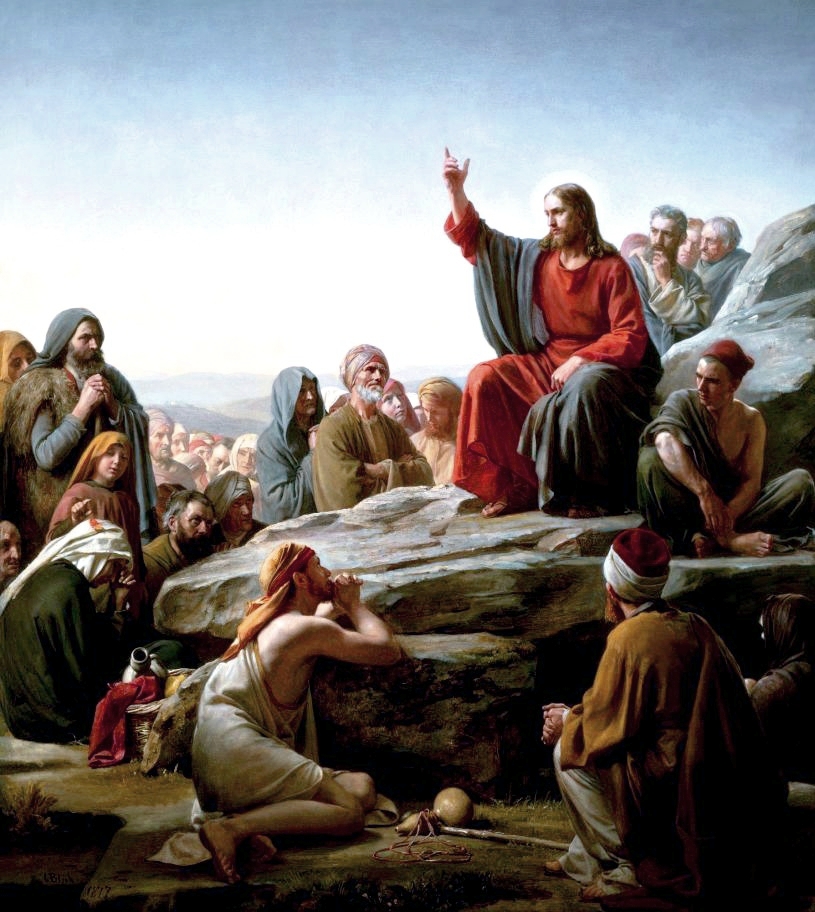
Das Christentum ist eine Weltreligion, die aus dem Judentum hervorging. Ihre Anhänger werden Christen genannt, die Gesamtheit der Christen wird auch als die Christenheit bezeichnet.
Von zentraler Bedeutung für das Christentum ist Jesus von Nazaret, ein jüdischer Wanderprediger, der etwa in den Jahren 28–30 unserer Zeitrechnung auftrat und in Jerusalem hingerichtet wurde. Seine Jünger erkannten in ihm nach seiner Kreuzigung und Auferstehung den Sohn Gottes und den vom Judentum erwarteten Messias. In ihren Bekenntnissen nennen sie ihn Jesus Christus. Der Glaube an ihn ist in den Schriften des Neuen Testaments grundgelegt. Die weitaus meisten Christen glauben an einen Gott (Monotheismus)[1] als eine Dreifaltigkeit, das heißt eine Wesenseinheit aus Vater, Sohn und Heiligem Geist.[2][3] Daneben existieren innerhalb des Christentums kleinere antitrinitarische Gruppierungen.[4][5]
Die zahlreichen Konfessionen bzw. Kirchen innerhalb des Christentums lassen sich in vier Hauptgruppen zusammenfassen: die römisch-katholische Kirche, die orthodoxen Kirchen, die protestantischen und die anglikanischen Kirchen. Mit rund 2,26 Milliarden Anhängern ist das Christentum vor dem Islam (über 1,8 Milliarden) und dem Hinduismus (rund 900 Millionen) die am weitesten verbreitete Religion weltweit.[6]
基督教相传于公元1, 2世纪时开始流传于罗马帝国统治下的各族人民之间,为耶稣所创立,初时为犹太教一个下层派别,后分裂为新的宗教。4世纪时,定为罗马帝国国教。当时的官方语为拉丁语,民间语为希腊语。中世纪基督教教会为欧洲封建社会的支柱,禁止人民思想自由,敌视科学研究。 以后基督教分为三大派别:天主教(Katholizismus)、东正教(Orthodox)和新教(Protestantismus)。
20世纪,世界基督教会联合会成立。截至21世纪初,基督徒超过二十亿人,约占全球人口三分之一,与佛教、伊斯兰教并列世界三大宗教, 并在中国五大宗教占据两席。 而天主教为首的教会,也成为世界上最大的非政府教育、医疗和慈善机构。
基督教是信仰耶稣基督为神之圣子与救世主(弥赛亚)的一神教。发源于西亚的巴勒斯坦地区,以《圣经》为最高宗教经典,信徒称为基督徒,基督徒组成的团体则称为教会或基督教会。由于部分教义源流自犹太教,因而被认为是亚伯拉罕诸教之一,现今亦与伊斯兰教、佛教共同视为世界三大宗教。其分为天主教、东正教、新教等三大宗派,但因历史发展的缘故,汉语所称的“基督教”常专指新教,基督教整体则又另以“基督宗教”、“基督信仰”或“广义基督教”称之。
基督教的共同信仰认为三位一体的独一神(汉语亦译为上帝或天主)创造了世界,并按照神自己的形像造人,由人来管理世界[1],后来人犯罪堕落,带来了死亡;圣父派遣其子耶稣道成肉身,在其在世33年的最后,为世人的罪被钉死在十字架上,在三天后从死里复活而后升天,赐下圣灵与信徒同在;他的死付上了罪的赎价,使一切信他的人得到拯救,并在神内有永生。
按照基督教在4世纪的历史纪载,第一个教会在耶稣升天与圣灵降临(约公元30至33年)后由耶稣的使徒建立,之后耶稣的使徒及信徒们不断向外宣教,并快速在当时管辖巴勒斯坦的罗马帝国境内及周边地区传播;虽曾长期遭罗马帝国政府迫害,但约于公元325年由君士坦丁大帝宣布合法化,狄奥多西大帝时更定为罗马帝国的国教,至此成为西方世界的主要宗教。之后因罗马帝国分裂后西方世界东西部的差异化发展,导致11世纪发生东西教会大分裂,形成以罗马教宗为首的公教会(天主教)、以及君士坦丁堡普世牧首为首的正教会(东正教)。16世纪时,西欧又爆发了反对教宗权威的宗教改革运动,马丁·路德(路德派)、约翰·喀尔文(喀尔文派)、乌里希·慈运理等神学家与英国国王亨利八世(安立甘派)先后脱离天主教而自立教会,日后出现了许多教义相近的教会,这些教会即为后世所统称的新教。
基督教虽起源于中东,但在7世纪创立的伊斯兰教兴起后,今日在当地的信徒人口反而居于少数。由于基督教重视传教事业(又称为“大使命”),加上西方国家自地理大发现以来对世界经济及文化发展上强势的影响力,使得基督教的传布范围遍及整个世界,基督教文化更成为世界许多文明的重要骨干。粗估统计全球超过三分之一的人口信仰基督教,至今信徒人口逾24亿,是当今世界信仰人口最多的宗教,三大宗派中又以天主教的信徒占约半数最多;基督徒最多的国家则是美国及巴西,大约占人口的75%[2][3]。
キリスト教(キリストきょう、基督教、ギリシア語: Χριστιανισμός、ラテン語: Religio Christiana、英語: Christianity)は、ナザレのイエスをキリスト(救い主)として信じる宗教[1][2]。イエス・キリストが、神の国の福音を説き、罪ある人間を救済するために自ら十字架にかけられ、復活したものと信じる[2]。その多く(カトリック教会[3]・聖公会[4]・プロテスタント[5][6][7][8]・正教会[9]・東方諸教会[10]など)は「父なる神」[注 1]と「その子キリスト」[注 2]と「聖霊」を唯一の神(三位一体・至聖三者)として信仰する。
世界における信者数は22億人を超えており、すべての宗教の中で最も多い[11]。
Christianity[note 1][2] is a Abrahamic monotheistic religion based on the life and teachings of Jesus of Nazareth as described in the New Testament. Its adherents, known as Christians, believe that Jesus Christ is the Son of God and savior of all people, whose coming as the Messiah was prophesied in the Old Testament.[3] Most Christians get baptized, celebrate the Lord's Supper, pray the Lord's Prayer and other prayers, have clergy, and attend group worship services.
Christianity began as a Second Temple Judaic sect in the 1st century in the Roman province of Judea. Jesus' apostles and their successors, the Apostolic Fathers, spread the religion across large parts of the Middle East, Europe, Ethiopia, Transcaucasia, and some other parts of Asia, despite initial persecution. The Roman emperor Constantine the Great converted to Christianity and decriminalized it in the Edict of Milan (313). He convened the First Council of Nicaea (325), where Early Christianity was consolidated into what would become the state religion of the Roman Empire (380).[4][5][6] The council formulated the Nicene Creed (325), and the Church Fathers supervised the compilation of the Christian Bible (5th century).[7] The period of the first seven ecumenical councils is sometimes referred to as the Great Church, the united full communion of the Catholic Church, Eastern Orthodox Church, and Oriental Orthodoxy before their schisms. Oriental Orthodoxy split after the Council of Chalcedon (451) over differences in Christology. The Eastern Orthodox Church and the Catholic Church separated in the East–West Schism (1054), especially over the authority of the Pope. Similarly, in 1521 Protestants were excommunicated from the Roman Catholic Church in the Protestant Reformation over Papal primacy, the nature of salvation and other ecclesiological and theological disputes.[8]
Christianity and Christian ethics have played a prominent role in the development of Western civilization,[9][10][11][12][13] particularly around Europe during Late Antiquity and the Middle Ages. Following the Age of Discovery (15th–17th century), Christianity was spread into the Americas, Oceania, sub-Saharan Africa and the rest of the world via missionary work and colonization.[14][15][16]
It is the world's most populous religious group,[17][18] with over 2.4 billion followers,[19][20][21] or 33% of the global population, comprising a majority of the population in about two-thirds of the countries in the world.[21] Today, the four largest branches of Christianity are the Catholic Church (1.3 billion), Protestantism (920 million), the Eastern Orthodox Church (260 million)[22] and Oriental Orthodoxy (86 million).
Le christianisme est une religion abrahamique, originaire du Proche-Orient, fondée sur l'enseignement, la personne et la vie de Jésus de Nazareth, tels qu'interprétés à partir du Nouveau Testament. Il s'agit d'une religion du salut considérant Jésus-Christ comme le Messie annoncé par les prophètes de l'Ancien Testament. La foi en la résurrection de Jésus est au cœur du christianisme car elle signifie le début d'un espoir d'éternité libéré du mal.
Les premières communautés chrétiennes naissent au Ier siècle en Judée et dans les grandes villes de la diaspora juive telles que Rome, Éphèse, Antioche et Alexandrie. Le christianisme se développe à partir du IIe siècle dans l'Empire romain, dont il devient la religion officielle à la fin du IVe siècle, mais aussi en Perse, en Inde et en Éthiopie. Au Moyen Âge, le christianisme devient majoritaire en Europe, tandis qu'il s'amenuise face à l'islam au Proche-Orient. Il est devenu la religion la plus importante de la planète en raison de son expansion en Amérique à partir du XVIe siècle et en Afrique depuis le XXe siècle. Il est actuellement présent dans tous les pays. En 2015, le nombre total de chrétiens dans le monde est évalué à 2,4 milliards, ce qui en fait la religion comptant le plus de fidèles, devant l'islam et l'hindouisme.
Les Églises chrétiennes sont regroupées en différentes branches, dont les principales sont le catholicisme, le christianisme orthodoxe et le protestantisme représentant respectivement 51 %, 11 % et 38 % du total des chrétiens en 2017.
Il cristianesimo è una religione a carattere universalistico, originatasi dal giudaismo nel I secolo, fondata sulla venuta e predicazione, contenuta nei Vangeli, di Gesù di Nazareth, inteso come figlio del Dio d'Israele e quindi Dio egli stesso, incarnato, morto e risorto per la salvezza dell'umanità, ovvero il Messia promesso, il Cristo.[1][2]
Insieme a ebraismo e islam, il cristianesimo è classificato da alcuni come "religione abramitica"[3][4], è una monolatria. Il Cristianesimo è la religione più diffusa, con una stima di circa 2,1 miliardi di fedeli nel mondo al 2000[5].
Il cristianesimo emerge dal giudaismo nel I secolo; alle origini si presenta con il duplice aspetto di giudeo-cristianesimo (i cui membri ritenevano che solo i circoncisi potevano essere salvati) ed etno-cristianesimo (o cristianesimo dei Gentili, che comunque devono osservare la legge di Mosè), come si desume dai racconti degli Atti di Luca e da alcune lettere di Paolo (come la Lettera ai Galati, le lettere ai Corinzi), mostrando tuttavia che le due anime convivono senza alcuna scissione, e di avere raggiunta una formula di concordia con il primo concilio di Gerusalemme (Atti 15).
I cristiani assunsero dal giudaismo le sue Sacre scritture, definite poi Antico Testamento, nella versione tradotta in greco ellenistico (anche a causa della prevalente origine greco-romana della maggioranza dei primi adepti), dottrine fondamentali come il monoteismo, la fede in un messia o cristo, alcune forme del culto (incluso il sacerdozio), concetti di luoghi e tempi sacri, l'idea che il culto debba essere modellato secondo il modello celeste, l'uso dei Salmi nelle preghiere comuni.
Il cristianesimo inteso come religione distinta da quella ebraica iniziò a delinearsi dopo il cosiddetto "Sinodo di Jamnia" in cui venne presa posizione decisa circa l'estraneità della "Via"[6] dall'ebraismo ortodosso, a partire dalla seconda metà del II secolo.
Successivamente la Chiesa post-apostolica lentamente si organizzò attorno alla cosiddetta pentarchia dei cinque patriarcati di Roma, Costantinopoli, Alessandria, Antiochia e Gerusalemme.
Inizialmente si ebbe una secolare contesa critica tra varie correnti per la formazione della prima Cristianità, correnti che si rifacevano a diverse raccolte di testi ritenuti sacri. Tale contesa terminò nel IV secolo con la conversione dell'Imperatore Costantino I (battezzato in punto di morte da un vescovo ariano[7]) il quale fece indire il Concilio di Nicea per far emergere una sola corrente ed eliminare le altre. Contestualmente la Cristianità divenne una religione approvata ufficialmente e i vescovi Cristiani, vittime in precedenza del potere militare, ne passarono al comando[8].
Nel 380 Teodosio con l'Editto di Tessalonica la rese l'unica religione ufficiale dell'impero romano ricorrendo anche a mezzi cruenti per reprimere le resistenze dei pagani.[9]
Nel 1054 contese teologiche circa i dogmi trinitari, il celibato ecclesiastico ed altre questioni minori culminarono nel Grande Scisma tra Chiesa cattolica e Chiesa ortodossa.
Circa cinque secoli dopo lo scandalo delle indulgenze spinse Lutero a causare un altro scisma e quindi a fondare il Protestantesimo.
Nell'Europa dell'est l'instaurazione di regimi marxisti, per definizione materialisti, ha avuto come conseguenza un processo di scristianizzazione pianificata di stato che è avvenuto iniziando dalla Russia (ex Unione Sovietica) e poi, nel dopoguerra, nei paesi governati da regimi comunisti satelliti dell'URSS. In seguito alla caduta dei regimi, dopo il 1989, è stata ristabilita, in buona parte dei casi, la libertà di culto.
El cristianismo (del latín christianismus, y este del griego χριστιανισμός)1 es una religión abrahámica monoteísta basada en la vida, enseñanzas y milagros de Jesús de Nazaret, tal y como se presentan en el Nuevo Testamento, que es la segunda parte de la Biblia, el libro sagrado de los cristianos. Con 2400 millones de seguidores,234 una de cada tres personas en el mundo es cristiana, por lo que es la religión más extensa del mundo.56 Los cristianos creen que Jesús es el hijo de Dios, así como el Mesías (o Cristo) profetizado en el Antiguo Testamento, que sufrió, fue crucificado, descendió al infierno y resucitó de entre los muertos para dar vida eterna a quienes crean y confíen en él para la redención de sus pecados. Las cuatro ramas más importantes del cristianismo son el catolicismo (1300 millones de adherentes), el protestantismo (920 millones), la Iglesia ortodoxa (270 millones) y las Iglesias ortodoxas orientales (86 millones). El movimiento que busca restaurar la unidad de la Iglesia cristiana recibe el nombre de ecumenismo.
El cristianismo surgió del judaísmo789 a mediados del siglo I d. C.1011 en la provincia romana de Judea. Los primeros líderes de las comunidades cristianas fueron los apóstoles y sus sucesores los padres apostólicos. Este cristianismo primitivo se extendió, pese a ser una religión minoritaria y perseguida, por Judea, Siria, Europa, Anatolia, Mesopotamia, Transcaucasia, Egipto y Etiopía. El cristianismo fue legalizado en el Imperio romano mediante el Edicto de Milán, en el año 313. El emperador Constantino se convirtió al cristianismo y convocó el Concilio de Nicea (325), en el que se formuló el credo niceno. El cristianismo se convirtió en la religión oficial del Imperio romano en el año 380, bajo el emperador Teodosio I el Grande.121314 Durante estos primeros siglos, los Padres de la Iglesia gradualmente consolidaron las doctrinas del cristianismo y supervisaron el desarrollo del canon del Nuevo Testamento.15
La Iglesia de los primeros siete concilios ecuménicos se conoce frecuentemente como la «Gran Iglesia», porque la Iglesia católica, la Iglesia ortodoxa y las Iglesias ortodoxas orientales estaban en plena comunión.16 Las Iglesias orientales se separaron tras el Concilio de Calcedonia (451) por diferencias cristológicas. La Iglesia ortodoxa se separó de la Iglesia católica en 1054 por diferencias acerca de la autoridad del papa. El protestantismo, aunque es en realidad un conjunto de denominaciones, aparece por primera vez durante la Reforma protestante del siglo XVI, y criticaban lo que percibían como importantes desviaciones teológicas y eclesiológicas por parte de la Iglesia católica.17 El descubrimiento de América en




 Architecture
Architecture
 History
History
 Art
Art
 Literature
Literature
 Music
Music
 World Heritage
World Heritage




